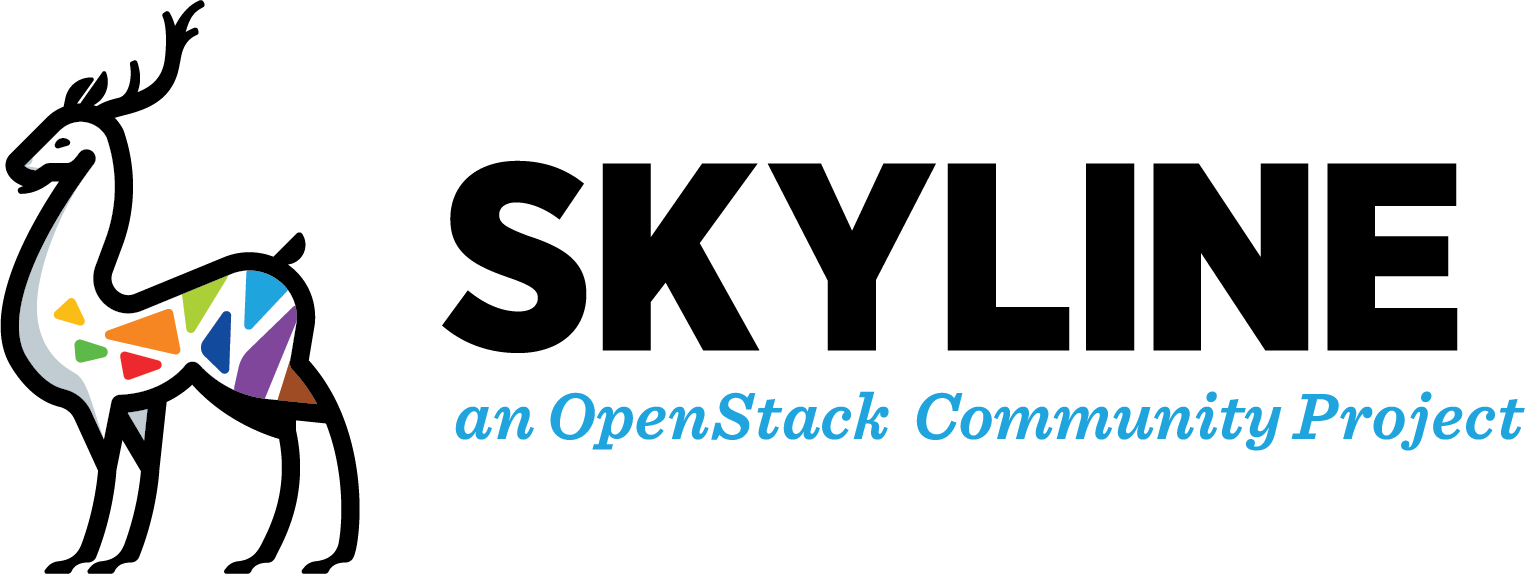Skyline API Server
English | 简体中文
Skyline is an OpenStack dashboard optimized by UI and UE, support OpenStack Train+. It has a modern technology stack and ecology, is easier for developers to maintain and operate by users, and has higher concurrency performance.
Skyline's mascot is the nine-color deer. The nine-color deer comes from Dunhuang mural “the nine-color king deer”, whose moral is Buddhist cause-effect and gratefulness, which is consistent with 99cloud's philosophy of embracing and feedback community since its inception. We also hope Skyline can keep light, elegant and powerful as the nine-color deer, to provide a better dashboard for the openstack community and users.
Table of contents
Resources
Quick Start
Prerequisites
- An OpenStack environment that runs at least core components and can access OpenStack components through Keystone endpoints
- A Linux server with container engine (docker or podman) installed
Configure
Edit the
/etc/skyline/skyline.yamlfile in linux serverYou can refer to the sample file, and modify the following parameters according to the actual environment
- database_url
- keystone_url
- default_region
- interface_type
- system_project_domain
- system_project
- system_user_domain
- system_user_name
- system_user_password
Deployment with Sqlite
Run the skyline_bootstrap container to bootstrap
rm -rf /tmp/skyline && mkdir /tmp/skyline docker run -d --name skyline_bootstrap -e KOLLA_BOOTSTRAP="" -v /etc/skyline/skyline.yaml:/etc/skyline/skyline.yaml -v /tmp/skyline:/tmp --net=host 99cloud/skyline:latest # Check bootstrap is normal `exit 0` docker logs skyline_bootstrap
Run the skyline service after bootstrap is complete
docker rm -f skyline_bootstrap
If you need to modify skyline port, add
-e LISTEN_ADDRESS=<ip:port>in the following commandLISTEN_ADDRESSdefaults to0.0.0.0:9999docker run -d --name skyline --restart=always -v /etc/skyline/skyline.yaml:/etc/skyline/skyline.yaml -v /tmp/skyline:/tmp --net=host 99cloud/skyline:latest
Deployment with MariaDB
Connect to database of the OpenStack environment and create the
skylinedatabase$ mysql -u root -p MariaDB [(none)]> CREATE DATABASE IF NOT EXISTS skyline DEFAULT CHARACTER SET utf8 DEFAULT COLLATE utf8_general_ci; Query OK, 1 row affected (0.001 sec)
Grant proper access to the databases
Replace
SKYLINE_DBPASSwith a suitable password.MariaDB [(none)]> GRANT ALL PRIVILEGES ON skyline.* TO 'skyline'@'localhost' IDENTIFIED BY 'SKYLINE_DBPASS'; Query OK, 0 rows affected (0.001 sec) MariaDB [(none)]> GRANT ALL PRIVILEGES ON skyline.* TO 'skyline'@'%' IDENTIFIED BY 'SKYLINE_DBPASS'; Query OK, 0 rows affected (0.001 sec)
Create skyline service credentials
# Source the admin credentials $ source admin-openrc # Create the skyline user $ openstack user create --domain default --password-prompt skyline User Password: Repeat User Password: +---------------------+----------------------------------+ | Field | Value | +---------------------+----------------------------------+ | domain_id | default | | enabled | True | | id | 1qaz2wsx3edc4rfv5tgb6yhn7ujm8ikl | | name | skyline | | options | {} | | password_expires_at | 2020-08-08T08:08:08.123456 | +---------------------+----------------------------------+ # Add the admin role to the skyline user: $ openstack role add --project service --user skyline admin
Run the skyline_bootstrap container to bootstrap
docker run -d --name skyline_bootstrap -e KOLLA_BOOTSTRAP="" -v /etc/skyline/skyline.yaml:/etc/skyline/skyline.yaml --net=host 99cloud/skyline:latest # Check bootstrap is normal `exit 0` docker logs skyline_bootstrap
Run the skyline service after bootstrap is complete
docker rm -f skyline_bootstrap
If you need to modify skyline port, add
-e LISTEN_ADDRESS=<ip:port>in the following commandLISTEN_ADDRESSdefaults to0.0.0.0:9999docker run -d --name skyline --restart=always -v /etc/skyline/skyline.yaml:/etc/skyline/skyline.yaml --net=host 99cloud/skyline:latest
Test Access
You can now access the dashboard: https://<ip_address>:9999
Develop Skyline-apiserver
Support Linux & Mac OS (Recommend Linux OS) (Because uvloop & cython)
Dependent tools
Use the new feature Context Variables of python37 & uvloop(0.15.0+ requires python37). Considering that most systems do not support python37, we choose to support python38 at least.
- make >= 3.82
- python >= 3.8
- node >= 10.22.0 (Optional if you only develop with apiserver)
- yarn >= 1.22.4 (Optional if you only develop with apiserver)
Install & Run
Installing dependency packages
tox -e venv
Set skyline.yaml config file
cp etc/skyline.yaml.sample etc/skyline.yaml export OS_CONFIG_DIR=$(pwd)/etc
Maybe you should change the params with your real environment as followed:
- database_url - keystone_url - default_region - interface_type - system_project_domain - system_project - system_user_domain - system_user_name - system_user_password
If you set such as
sqlite:////tmp/skyline.dbfordatabase_url, just do as followed. If you set such asmysql://root:root@localhost:3306/skylinefordatabase_url, you should refer to steps1and2of the chapterDeployment with MariaDBat first.Init skyline database
source .tox/venv/bin/activate make db_sync deactivateRun skyline-apiserver
$ source .tox/venv/bin/activate $ uvicorn --reload --reload-dir skyline_apiserver --port 28000 --log-level debug skyline_apiserver.main:app INFO: Uvicorn running on http://127.0.0.1:28000 (Press CTRL+C to quit) INFO: Started reloader process [154033] using statreload INFO: Started server process [154037] INFO: Waiting for application startup. INFO: Application startup complete.
You can now access the online API documentation:
http://127.0.0.1:28000/docs.Or, you can launch debugger with
.vscode/lauch.jsonwith vscode.Build Image
make build
Devstack Integration
Fast integration with Devstack to build an environment.

